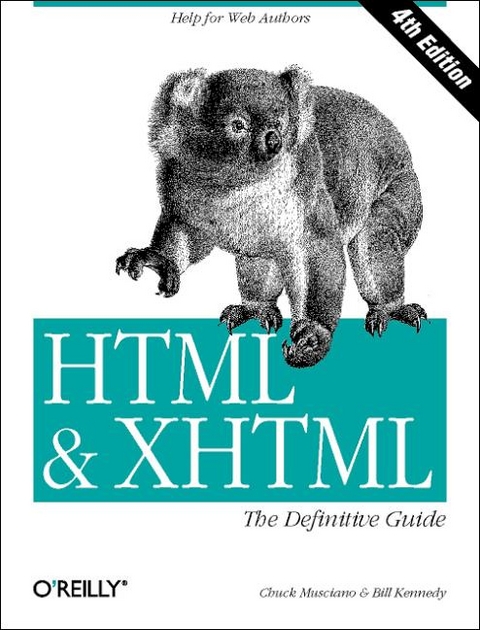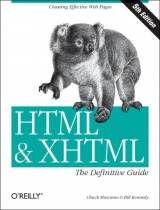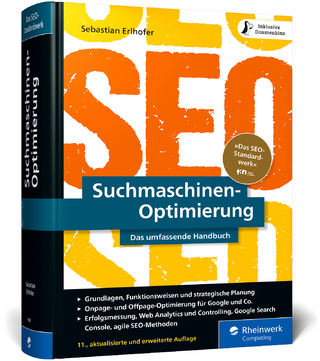
HTML and XHTML
O'Reilly Media (Verlag)
978-0-596-00026-4 (ISBN)
- Titel erscheint in neuer Auflage
- Artikel merken
HTML is changing so fast it's almost impossible to keep up with developments. XHTML is HTML 4.0 rewritten in XML; it provides the precision of XML while retaining the flexibility of HTML. This text brings it all together. It covers Netscape Navigator 6.0, Internet Explorer 5.0, HTML 4.01, XHTML 1.0, JavaScript, Style sheets, Layers, and all of the features supported by the popular web browsers. Learning HTML and XHTML is like learning any new language, computer or human. Most students first immerse themselves in examples. Studying others is a natural way to learn, making learning easy and fun. Imitation can take learning only so far, though. It's as easy to learn bad habits through imitation as it is to acquire good ones. The better way to become HTML-fluent is through a comprehensive reference that covers the language syntax, semantics, and variations in detail and demonstrates the difference between good and bad usage. This book helps in both ways: the authors cover every element of HTML/XHTML in detail, explaining how each element works and how it interacts with other elements.
Many hints about HTML/XHTML style smooth the way for writing documents that range from simple online documentation to complex presentations. With hundreds of examples, the book gives Web authors models for writing their own effective Web pages and for mastering advanced features, like style sheets and frames. It shows how to: implement the XHTML 1.0 standard and prepare Web pages for the transition to XML browsers; use style sheets and layers to control a document's appearance; create tables, from simple to complex; use frames to coordinate sets of documents; design and build interactive forms and dynamic documents; insert images, sound files, video, Java applets, and JavaScript programs; create documents that look good on a variety of browsers; use new features to support multiple languages; and the book comes with a handy quick reference card listing HTML tags.
Chuck Musciano has spent his life on the East Coast, living in Maryland, Georgia, and New Jersey before acquiring a B.S. in computer science from Georgia Tech in 1982. He began his career as a compiler writer and crafter of tools and then went on to join Harris Corporation's Advanced Technology Group, where he helped develop large-scale multiprocessors. His prolonged interest in user-interface research and development finally gave way to a position as manager of Unix systems in Harris' Corporate Data Center. He left Harris in 1997 to become the chief information officer of the American Kennel Club in Raleigh, North Carolina. There he focuses on re-engineering their legacy information systems to exploit client/server technology over the Internet. Throughout his career, he has known and loved the Internet, having contributed a number of publicly available tools to the Net, and helped start the Internet Movie Database. Chuck has written on Unix- and web-related topics in the trade press for the past decade, most visibly as the "webmaster" columnist for Sunworld Online and the "Tag of the Week" columnist for Web Review. In his spare time he enjoys life in North Carolina with his wife Cindy, daughter Courtney, and son Cole. He can be reached at cmusciano@aol.com. Bill Kennedy is currently president and chief technical officer of ActivMedia, Inc., a new media marketing and marketing research company based in beautiful Peterborough, NH, but which conducts business with clients and associates from around the world, primarily over the Internet. When not hacking new HTML pages or writing about them, "Dr. Bill" (Ph.D. in biophysics of all things) is out promoting a line of intelligent mobile robots as real-world platforms for artificial intelligence and fuzzy logic research and for education. Contact Dr. Bill directly at bkennedy@activmedia.com.
Preface. 1. HTML, XHTML, and the World Wide Web 1.1. The Internet, Intranets,and Extranets 1.2. Talking the Internet Talk 1.3. HTML: What It Is 1.4. XHTML: What It Is 1.5. HTML and XHTML: What They Aren't 1.6. Nonstandard Extensions 1.7. Tools for the Web Designer. 2. Quick Start 2.1. Writing Tools 2.2. A First HTML Document 2.3. Embedded Tags 2.4. HTML skeleton 2.5. The Flesh on an HTML or XHTML Document 2.6. Text 2.7. Hyperlinks 2.8. Images Are Special 2.9. Lists, Searchable Documents, and Forms 2.10. Tables 2.11. Frames 2.12. Style Sheets and JavaScript 2.13. Forging Ahead. 3. Anatomy of an HTML Document 3.1. Appearances Can Deceive 3.2. Structure of an HTML Document 3.3. Tags and Attributes 3.4. Well-Formed Documents and XHTML 3.5. Document Content 3.6. HTML Document Elements 3.7. The Document Header 3.8. The Document Body 3.9. Editorial Markup 3.10. The Tag. 4. Text Basics 4.1. Divisions and Paragraphs 4.2. Headings 4.3. Changing Text Appearance 4.4. Content-Based Style Tags 4.5. Physical Style Tags 4.6. HTML's Expanded Font Handling 4.7. Precise Spacing and Layout 4.8. Block Quotes 4.9. Addresses 4.10. Special Character Encoding. 5. Rules, Images, and Multimedia 5.1. Horizontal Rules 5.2. Inserting Images in Your Documents 5.3. Document Colors and Background Images 5.4. Background Audio 5.5. Animated Text 5.6. Other Multimedia Content 6. Links and Webs 6.1. Hypertext Basics 6.2. Referencing Documents: The URL 6.3. Creating Hyperlinks 6.4. Creating Effective Links 6.5. Mouse-Sensitive Images 6.6. Creating Searchable Documents 6.7. Relationships 6.8. Supporting Document Automation. 7. Formatted Lists 7.1. Unordered Lists 7.2. Ordered Lists 7.3. The Tag 7.4. Nesting Lists 7.5. Definition Lists 7.6. Appropriate List Usage 7.7. Directory Lists 7.8. Menu Lists. 8. Cascading Style Sheets 8.1. The Elements of Styles 8.2. Style Syntax 8.3. Style Classes 8.4. Style Properties 8.5. Tag-less Styles: The Tag 8.6. Applying Styles to Documents. 9. Forms 9.1. Form Fundamentals 9.2. The Tag 9.3. A Simple Form Example 9.4. Using Email to Collect Form Data 9.5. The Tag 9.6. The Tag 9.7. Multiline Text Areas 9.8. Multiple Choice Elements 9.9. General Form Control Attributes 9.10. Labeling and Grouping Form Elements 9.11. Creating Effective Forms 9.12. Forms Programming. 10. Tables 10.1. The Standard Table Model 10.2. Table Tags 10.3. Newest Table Tags 10.4. Beyond Ordinary Tables. 11. Frames 11.1. An Overview of Frames 11.2. Frame Tags 11.3. Frame Layout 11.4. Frame Contents 11.5. The Tag 11.6. Inline Frames 11.7. Named Frame or Window Targets. 12. Executable Content 12.1. Applets and Objects 12.2. Embedded Content 12.3. JavaScript 12.4. JavaScript Style Sheets. 13. Dynamic Documents 13.1. An Overview of Dynamiic Documents 13.2. Client-Pull Documents 13.3. Server -Push Documents. 14. Netscape Layout Extensions 14.1. Creating Whitespace 14.2. Multicolumn Layout 14.3. Layers. 15. XML 15.1. Languages and Metalanguages 15.2. Documents and DTDs 15.3. Understanding XML DTDs 15.4. Element Grammar 15.5. Element Attributes 15.6. Conditional Sections 15.7. Building an XML DTD 15.8. Using XML. 16. XHTML 16.1. Why XHTML? 16.2. Creating XHTML Documents 16.3. HTML Versus XHTML 16.4. Should You Use XHTML? 17. Tips, Tricks, and Hacks 17.1. Top of the Tips 17.2. Trivial or Abusive? 17.3. Custom Bullets 17.4. Tricks with Tables 17.5. Transparent Images 17.6. Tricks with Windows and Frames A. HTML Grammar B. HTML/XHTML Tag Quick Reference Core Attributes C. Cascading Style Sheet Properties Quick Reference D. The HTML 4.01 DTD E. The XHTML 1.0 DTD F. Character Entities G. Color Names and Values Index
| Erscheint lt. Verlag | 5.9.2000 |
|---|---|
| Zusatzinfo | index |
| Verlagsort | Sebastopol |
| Sprache | englisch |
| Maße | 178 x 229 mm |
| Gewicht | 980 g |
| Einbandart | kartoniert |
| Themenwelt | Informatik ► Web / Internet ► Web Design / Usability |
| ISBN-10 | 0-596-00026-X / 059600026X |
| ISBN-13 | 978-0-596-00026-4 / 9780596000264 |
| Zustand | Neuware |
| Informationen gemäß Produktsicherheitsverordnung (GPSR) | |
| Haben Sie eine Frage zum Produkt? |
aus dem Bereich



